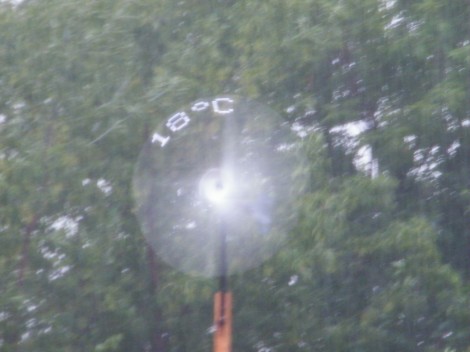
The more we think about this one the more we like it. [Michael] built himself a wind-powered persistence-of-vision weather station. Okay, that sounds interesting, but he ups the ante when you find out what’s included in the system.
A stepper motor acts as the generator which powers the electronics. As we’ve seen before; if you spin the shaft of a stepper motor electricity is produced. [Michael] is actually spinning the housing of the motor, with the shaft mounted to the base that holds the weather station in place. This way, the electrical contacts are spinning along with the blades of the generator. By mounting all of the electronics on these blades he gets around the problem of transferring power onto a spinning platform.
A set of LEDs on the end of the blades display temperature and relative humidity readings. A hall effect sensor pulled form an old floppy drive syncs the display with the rotational speed. He’s even got a shunt system which keeps the input voltage at a safe level, and will act as a break in high winds to keep the rotors from spinning out of control. See what we mean? An interesting idea because a fantastic project when you build in features like these!















Great.
The next model could incorporate a wind speed and direction reading.
I thought about wind speed and rpm but figured as the load(LEDs) changed with the display it would not be very accurate.
And I included a resistive divider to measure the generator voltage but didn’t bother to write in the code for it…
Michael
I would assume that the shunt acts as a brake, not a break. Yes, neat project, clever design spinning the motor.
The brake keeps it from breaking…
“An interesting idea because a fantastic project when you build in features like these!”
UMMWTF?
… caffeine.
Lovely project!
Though I’m surprised he used a hall-sensor when he could have gotten position information from just detecting which motor phase was generating. Sense off one, number of steps devided by number of phases.
Using the stepper motor phase information wouldn’t tell you absolute position, so you couldn’t get the POV display upright. You could measure rotational speed, but not position. (Remember the stepper motor has over 100 steps per revolution.)
Ah, good point.
I wondered the same thing. That’s a very educational and insightful.
i smell an unconcentrated because words newsposter mashup. probebly legistaniec to
Please send your CV to HaD for prompt review.
+1!
i like the concept,
a simple station to give weather data at a glance to anyone passing by.
Am I missing something? I think I have to live in a very windy place to be able to wake up and have my dependable weather reading available for me. No wind = ?
GD people and their fixin spellin miztakes.
This project is sweet, really really cool. I want one
this project reminds me of http://www.meso.net/Siemens-Hope09
Reminds me not to throw away my electronic junk and get creative. Let’s see Philips Nino PDA that my wife never used, HP laptop with failed display, DC-DC converters that I got in lieu of sales commission, iOmega external storage drive,PC-XT compatible Harman-Kardon speakers…Looking for ideas.
Ravi, use the DC-DC converters to drive the Harman-Kardon speakers by modulating the feedback, use an audio source for the modulation input.
Then hinge a bit of mirror on the speaker and shine a laser at it for a sound modulated light show…
I’ve always wanted to hear what different SMPS’s would sound like if used as an audio amplifier.
Someday I might get around to giving it a try…
This is indeed a neat project. The concept of using the body of the stepper as the rotating element to avoid brushes and sliprings is purely brilliant. I love it! Yes, the hall pickup has to be there to establish a reference point because the stepper serves as an incremental encoder only. The one potential source of error is any nonlinearity in the rotation speed versus the wind speed. I would be interested in knowing at what speed you start to apply braking. Also, the picture shows a temperature display, I think, so I assume that it has a temperature sensor also.
Are detailed plans for this project published anyplace? This is one cool project, Indeed!
William, the braking speed will be variable with the load. As the display lights it causes the stepper supply voltage to dip as current is drawn thru the SMPS.
The sensor is an SHT21, a combination humidity and temperature sensor with a digital output. It’s connected by way of the i2c bus.
Cool project. For non-windy days, it maybe possible to parallel the shunt with battery charging, so the charging action is applying the ‘brake’ on Very windy days, then on non-windy days, use the stored energy to periodically spin the blades and display the information?
Just a thought.
Steve
Batteries would be more of a challenge as
1) They would have to spin to avoid slip rings
2) Canadian winters are very cold
The windmill has been going all winter with nothing protecting PCB but a couple of coats of clear acrylic spray paint..